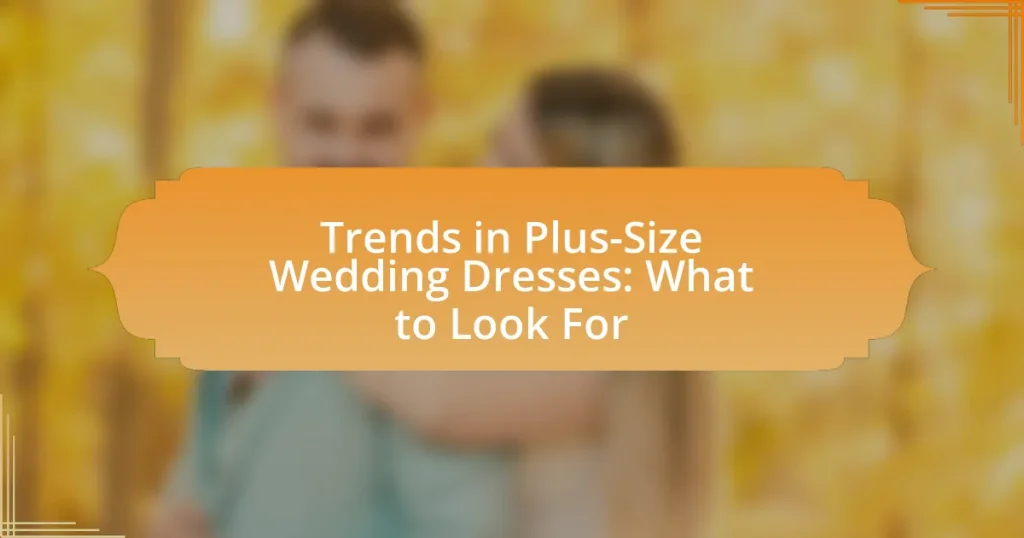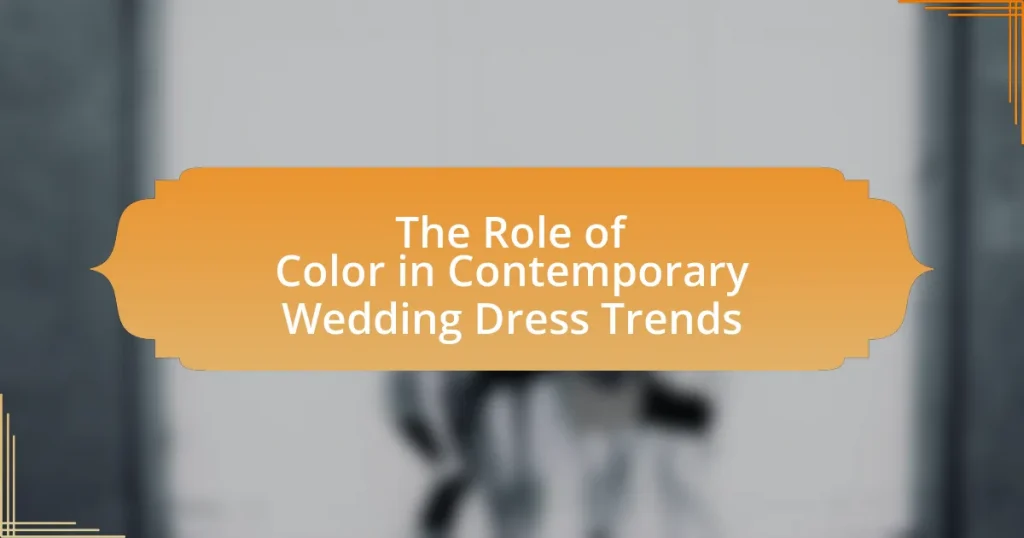The article examines the evolution of wedding veils, tracing their history from ancient civilizations to contemporary bridal fashion. It highlights the symbolic meanings associated with veils, such as modesty and purity, and discusses how cultural influences have shaped their design over time. Key styles of wedding veils through the decades are outlined, including the impact of significant social movements and fashion trends. Additionally, the article addresses practical considerations for selecting and caring for wedding veils, ensuring they complement the bride’s overall look while reflecting personal style.
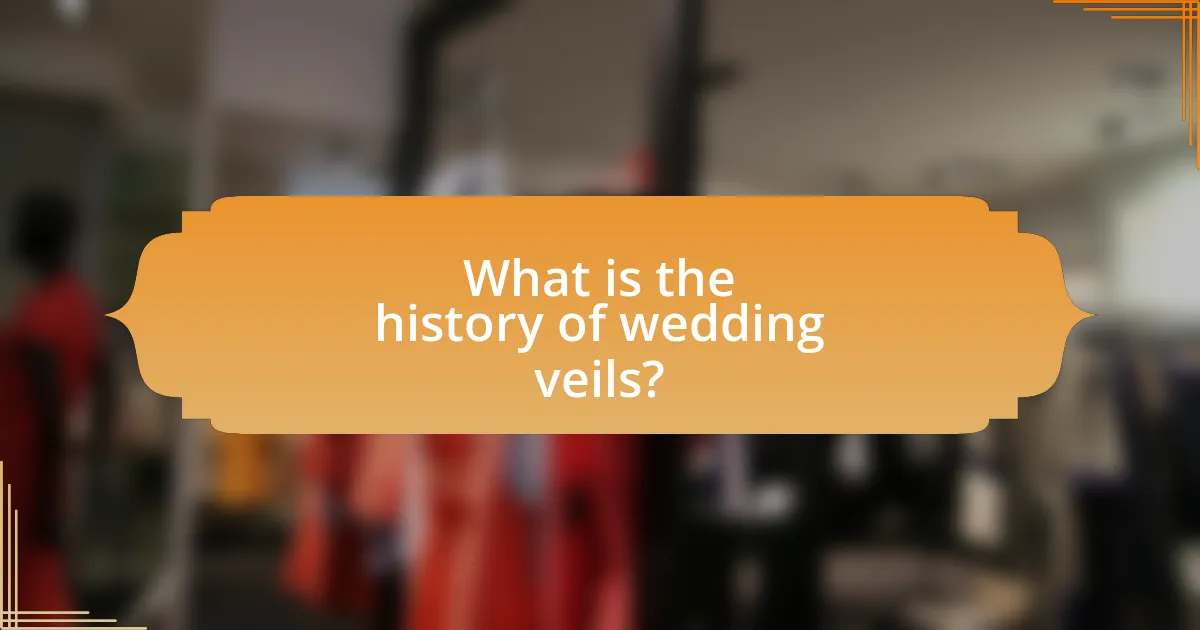
What is the history of wedding veils?
The history of wedding veils dates back to ancient civilizations, where they were used to symbolize modesty and purity. In ancient Rome, brides wore a flammeum, a bright orange veil, to ward off evil spirits and ensure fertility. During the Middle Ages, veils became more elaborate, often made of fine fabrics, and were associated with the bride’s social status. By the 19th century, the white wedding veil emerged as a symbol of innocence, popularized by Queen Victoria during her marriage to Prince Albert in 1840. This trend solidified the veil’s place in Western wedding traditions, leading to various styles and meanings that evolved throughout the 20th century, reflecting cultural shifts and personal expressions in bridal fashion.
How have wedding veils evolved over time?
Wedding veils have evolved significantly from their origins in ancient civilizations to modern-day fashion statements. Initially, veils served practical purposes, such as protecting brides from evil spirits and symbolizing modesty, as seen in ancient Rome and Greece. During the Middle Ages, veils became more elaborate, often made of luxurious fabrics and adorned with embroidery, reflecting the social status of the bride. In the 19th century, Queen Victoria popularized the white wedding veil, linking it to purity and innocence, which influenced bridal fashion for generations. Today, wedding veils vary widely in style, length, and material, ranging from traditional lace to contemporary designs, showcasing personal expression and cultural significance. This evolution illustrates how wedding veils have transitioned from functional items to symbols of individual style and tradition in modern weddings.
What were the earliest forms of wedding veils?
The earliest forms of wedding veils can be traced back to ancient civilizations, particularly in Roman and Greek cultures. In these societies, brides wore simple, translucent fabrics to symbolize modesty and purity. Historical evidence indicates that the Romans used a “flammeum,” a bright orange veil, to cover the bride’s face during the ceremony, while the Greeks employed a “sambenito,” a veil that was often adorned with flowers. These early veils served both practical and symbolic purposes, representing the bride’s transition into marriage and her protection from evil spirits.
How did cultural influences shape the design of wedding veils?
Cultural influences significantly shaped the design of wedding veils by incorporating various traditions, materials, and symbolism from different societies. For instance, in ancient Rome, brides wore veils called “flammeum,” which symbolized modesty and protection, reflecting societal values of the time. In contrast, Victorian-era veils often featured lace and intricate embroidery, influenced by the romantic ideals of the period and the importance of social status. Additionally, in many cultures, the color and length of the veil are tied to specific customs; for example, white veils became popular in Western weddings due to Queen Victoria’s choice in 1840, symbolizing purity. These examples illustrate how cultural contexts have historically dictated the aesthetics and meanings associated with wedding veils.
What significance do wedding veils hold in different cultures?
Wedding veils hold significant cultural meanings across various societies, often symbolizing purity, modesty, and the transition into marriage. In Western cultures, veils traditionally represent a bride’s chastity and are often worn to signify her transition from maidenhood to married life. In some Middle Eastern cultures, veils serve as a form of modesty and protection, reflecting cultural values regarding women’s roles and societal expectations. In Hindu weddings, the veil, known as a “ghunghat,” symbolizes respect and devotion, as the bride covers her face during the ceremony. These cultural interpretations highlight the veil’s role in expressing identity, tradition, and the values associated with marriage in different societies.
Why are wedding veils considered a symbol of purity?
Wedding veils are considered a symbol of purity because they historically represent modesty and innocence in brides. This association dates back to ancient traditions where veils were used to shield the bride from the gaze of onlookers, signifying her purity and virtue. In many cultures, the act of wearing a veil during the wedding ceremony has been linked to the idea of the bride being untouched and chaste, reinforcing the notion of purity as a valued trait in marriage.
How do various cultures incorporate veils into their wedding traditions?
Various cultures incorporate veils into their wedding traditions as symbols of modesty, purity, and protection. In Western cultures, brides often wear white veils to signify innocence and to create a visual connection to traditional bridal attire. In Middle Eastern cultures, the hijab or other forms of veiling are worn to reflect cultural values of modesty and respect. In Indian weddings, brides may wear a dupatta, a long scarf that covers their head and shoulders, symbolizing their transition into married life. Historical practices, such as the Roman tradition of brides wearing a flame-colored veil to ward off evil spirits, further illustrate the diverse meanings attached to veils across different cultures.
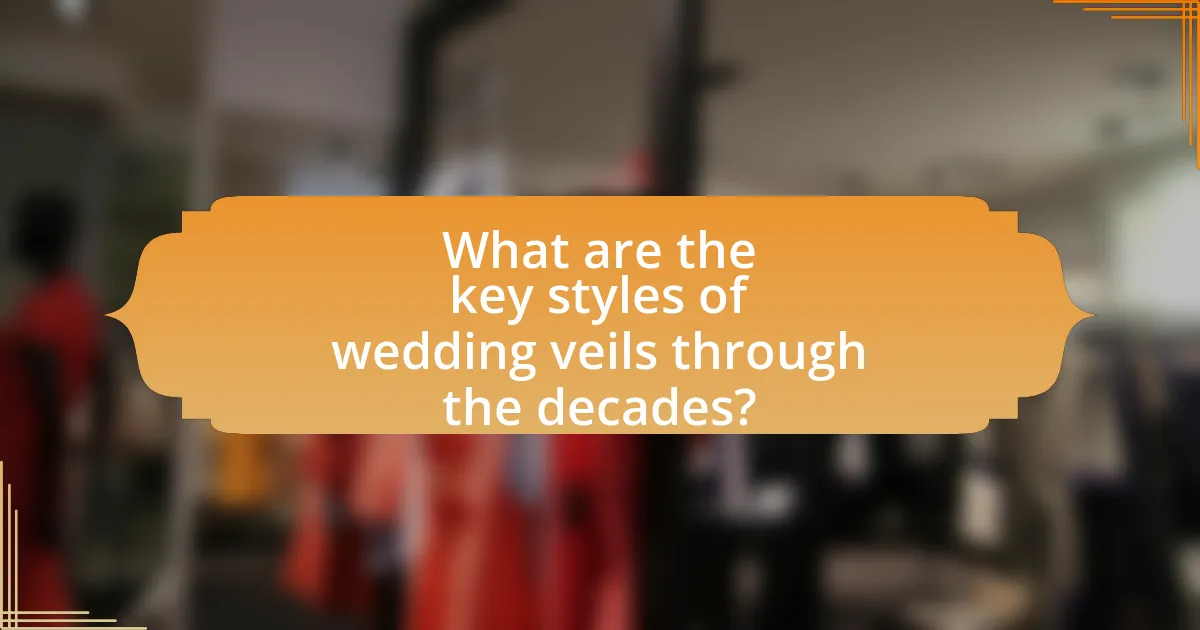
What are the key styles of wedding veils through the decades?
The key styles of wedding veils through the decades include the following: In the 1920s, short, blusher veils became popular, often worn with cloche hats. The 1930s saw longer, flowing veils, typically made of tulle, which complemented the elegant silhouettes of wedding gowns. The 1940s introduced the birdcage veil, a short, netted style that added a vintage charm. In the 1950s, cathedral-length veils emerged, symbolizing grandeur and tradition, often paired with ball gown dresses. The 1960s favored simpler, shorter veils, reflecting the era’s minimalist aesthetic. The 1980s brought back voluminous, layered veils, often adorned with lace and embellishments, aligning with the decade’s extravagant fashion. In the 2000s, modern brides opted for a mix of styles, including fingertip and chapel-length veils, often incorporating personal touches like embroidery or unique fabrics. Each decade’s veil style reflects broader fashion trends and cultural influences, showcasing the evolution of bridal aesthetics over time.
How did the 1920s influence wedding veil styles?
The 1920s significantly influenced wedding veil styles by introducing shorter, more modern designs that reflected the era’s fashion trends. During this decade, the flapper movement popularized a more liberated approach to women’s fashion, leading to veils that were often knee-length or shorter, contrasting with the longer, traditional styles of previous decades. Additionally, the use of lighter fabrics such as tulle and lace became prevalent, allowing for more intricate embellishments and a delicate appearance. This shift in veil styles mirrored the overall cultural changes of the 1920s, where women sought to express their individuality and embrace a more contemporary aesthetic in their wedding attire.
What were the popular materials used for veils in the 1920s?
In the 1920s, popular materials used for veils included tulle, lace, and silk. Tulle, a lightweight and sheer fabric, became a favored choice for its delicate appearance and versatility in design. Lace added an element of elegance and was often used to create intricate patterns, enhancing the overall aesthetic of the veil. Silk, known for its luxurious feel and sheen, was also commonly utilized, providing a sophisticated look that complemented the fashion of the era. These materials reflected the broader trends of the 1920s, which emphasized both simplicity and elegance in bridal attire.
How did fashion trends of the 1920s impact veil designs?
Fashion trends of the 1920s significantly influenced veil designs by introducing shorter lengths and more intricate embellishments. The flapper style, characterized by its modernity and liberation, led to veils that were often worn at shoulder length or even shorter, contrasting with the longer, more traditional veils of previous decades. Additionally, the use of lace, beading, and feathers became popular, reflecting the era’s emphasis on glamour and sophistication. This shift in veil design was a direct response to the overall fashion movement that celebrated a more relaxed and playful approach to women’s attire during the Roaring Twenties.
What changes occurred in wedding veil styles during the 1960s?
During the 1960s, wedding veil styles transitioned towards more modern and minimalist designs, reflecting the broader cultural shifts of the era. The decade saw a move away from the elaborate, tiered veils of previous decades to simpler, more streamlined options, often featuring a single layer of tulle or lace. This change was influenced by the rise of the feminist movement and a desire for practicality and comfort in bridal attire. Notably, the iconic bridal look of the time was epitomized by the veil worn by Jacqueline Kennedy during her wedding in 1953, which set a trend for shorter, more elegant veils that continued into the 1960s.
What were the defining characteristics of 1960s wedding veils?
The defining characteristics of 1960s wedding veils included their length, style, and materials. Veils during this decade often featured long, flowing designs that extended well beyond the bride’s train, with many reaching the floor or even pooling around it. The styles varied from simple, sheer fabrics to more elaborate designs adorned with lace or embroidery. Additionally, the use of materials like tulle and organza became prominent, reflecting the era’s preference for lightweight and ethereal looks. The influence of popular culture, including the rise of the mod fashion movement, also led to unique styles such as shorter veils and headpieces that complemented the overall bridal aesthetic of the time.
How did social movements influence the styles of veils in the 1960s?
Social movements in the 1960s significantly influenced the styles of veils, reflecting broader cultural shifts towards individualism and feminism. The rise of the women’s liberation movement encouraged brides to choose veils that symbolized personal expression rather than traditional conformity, leading to a variety of styles that included shorter, more casual designs. Additionally, the counterculture movement embraced non-traditional aesthetics, resulting in veils that incorporated bold colors and unconventional materials, moving away from the classic white lace. This shift was evident in bridal fashion shows and magazines of the time, which began showcasing diverse veil styles that aligned with the era’s progressive values.
What modern trends are shaping wedding veils today?
Modern trends shaping wedding veils today include the use of non-traditional materials, minimalist designs, and personalization options. Non-traditional materials such as lace, tulle, and even floral elements are increasingly popular, allowing brides to express their unique style. Minimalist designs focus on clean lines and simplicity, reflecting a broader trend in wedding aesthetics towards understated elegance. Personalization options, including custom embroidery and unique embellishments, enable brides to incorporate personal touches that resonate with their individual stories. These trends are supported by the growing demand for unique and personalized wedding experiences, as evidenced by a 2022 survey from The Knot, which reported that 70% of couples seek to reflect their personalities in their wedding attire and accessories.
How are contemporary brides personalizing their veils?
Contemporary brides are personalizing their veils by incorporating unique elements such as custom embroidery, personalized messages, and distinctive fabrics. Many brides choose to add their initials, wedding dates, or meaningful quotes to their veils through embroidery, making each piece a reflection of their personal story. Additionally, the use of non-traditional materials like lace, tulle, or even colored fabrics allows brides to express their individual style and complement their wedding theme. This trend is supported by the growing popularity of bespoke bridal accessories, which cater to the desire for personalization in modern weddings.
What materials and designs are currently popular for wedding veils?
Currently, popular materials for wedding veils include tulle, lace, and chiffon, while designs often feature cathedral lengths, birdcage styles, and embellished edges. Tulle is favored for its lightweight and ethereal quality, making it a staple in modern bridal fashion. Lace adds a touch of vintage elegance, often seen in veils that complement intricate wedding gowns. Chiffon is appreciated for its soft drape and flow, providing a romantic look. The cathedral length veil, which extends beyond the train of the gown, is particularly trendy for its dramatic effect, while birdcage veils offer a retro charm. Embellishments like beading and floral appliqués are also popular, enhancing the overall bridal aesthetic.
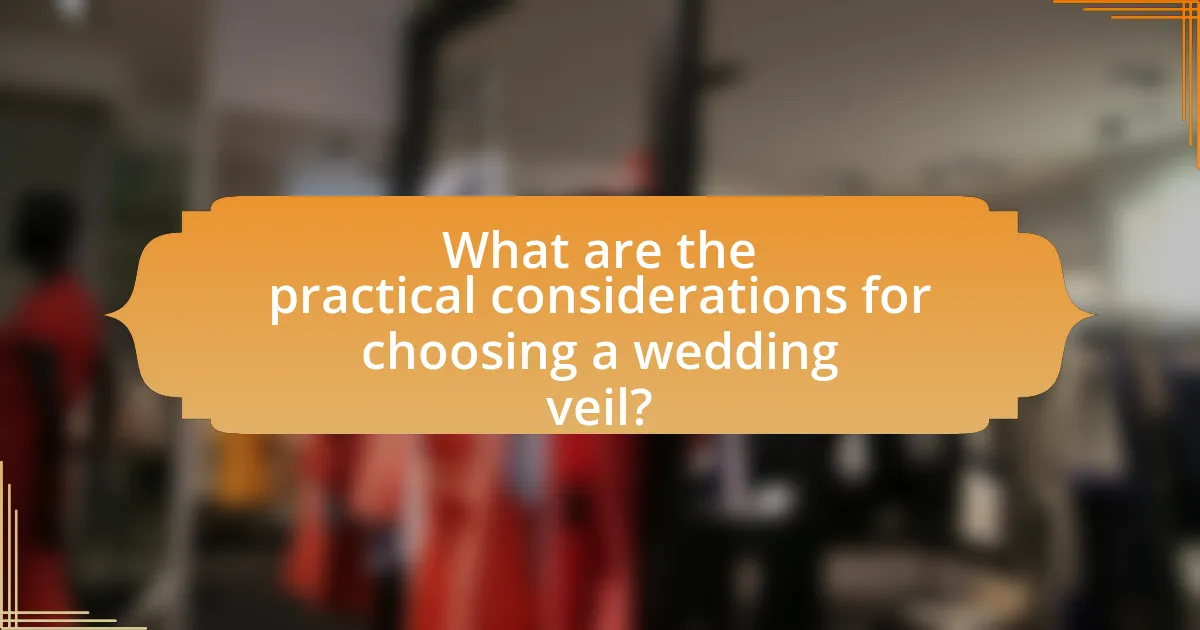
What are the practical considerations for choosing a wedding veil?
When choosing a wedding veil, practical considerations include the veil’s length, style, fabric, and how it complements the wedding dress. The length of the veil should match the formality of the wedding and the bride’s height; for example, a cathedral veil is suitable for formal settings, while a shorter veil may be better for casual weddings. The style of the veil should harmonize with the dress’s design, whether it be lace, tulle, or a more modern fabric, ensuring a cohesive look. Additionally, the fabric’s weight and texture can affect comfort and movement, as heavier materials may be cumbersome. These considerations are essential for achieving both aesthetic appeal and practicality on the wedding day.
How do you select the right veil for your wedding dress?
To select the right veil for your wedding dress, consider the dress’s style, length, and embellishments. A veil should complement the dress, enhancing its features without overwhelming them. For example, a simple gown pairs well with a more intricate veil, while a heavily embellished dress may require a simpler veil to maintain balance. Additionally, the length of the veil should correspond with the dress’s silhouette; a long veil suits a formal gown, while a shorter veil works well with a casual dress. Historical trends show that veils have evolved, with styles ranging from cathedral-length to birdcage, reflecting the bride’s personal style and the wedding’s overall theme.
What factors should be considered regarding length and style?
When considering length and style in wedding veils, factors such as the bride’s height, dress silhouette, and wedding theme are crucial. The bride’s height influences how a veil’s length complements her overall appearance; for instance, taller brides may opt for longer veils to create balance, while shorter brides might choose shorter styles to avoid overwhelming their frame. The dress silhouette also plays a significant role; a fitted gown pairs well with a sleek veil, while a ball gown may be enhanced by a fuller, longer veil. Additionally, the wedding theme dictates the veil’s style; a vintage-themed wedding might favor lace or antique styles, whereas a modern wedding could lean towards minimalist designs. These considerations ensure that the veil enhances the bride’s look and aligns with the overall aesthetic of the wedding.
How does the venue influence veil selection?
The venue significantly influences veil selection by dictating the style, length, and material of the veil to complement the overall aesthetic of the location. For instance, a formal church setting may encourage the choice of a longer, more traditional veil, while a beach wedding might lead to a preference for lighter, shorter veils that are more practical in windy conditions. Additionally, the color palette and architectural features of the venue can guide the bride in selecting a veil that harmonizes with her dress and the surroundings, ensuring a cohesive look for the event.
What tips can help brides care for their wedding veils?
To care for wedding veils, brides should store them properly, clean them gently, and avoid exposure to harsh elements. Proper storage involves hanging the veil in a breathable garment bag to prevent creasing and damage. Gentle cleaning can be achieved by using a soft cloth or a specialized veil cleaner, as many veils are made from delicate materials like tulle or lace that can be easily damaged by harsh chemicals. Additionally, brides should keep their veils away from direct sunlight and moisture to maintain the fabric’s integrity and color. These practices help preserve the veil’s condition and ensure it remains a cherished keepsake.
How should a wedding veil be stored before the big day?
A wedding veil should be stored in a cool, dry place, ideally in a breathable garment bag or wrapped in acid-free tissue paper to prevent creasing and damage. This method protects the veil from dust, moisture, and light exposure, which can lead to discoloration or deterioration. Proper storage ensures that the veil remains in pristine condition for the wedding day, allowing it to maintain its intended beauty and elegance.
What cleaning methods are safe for different veil materials?
Safe cleaning methods for different veil materials vary based on the fabric type. For silk veils, dry cleaning is recommended to prevent damage, while polyester veils can be hand-washed in cold water with mild detergent. Lace veils should be spot cleaned with a gentle fabric cleaner to maintain their delicate structure. Tulle veils can be gently hand-washed or steamed to remove wrinkles without compromising the material. These methods ensure the longevity and integrity of the veil, as improper cleaning can lead to discoloration or fabric degradation.
What are the most common mistakes to avoid when choosing a wedding veil?
The most common mistakes to avoid when choosing a wedding veil include selecting a veil that does not complement the wedding dress, ignoring the venue’s style and theme, and failing to consider the length and fabric of the veil in relation to the bride’s height and hairstyle. Choosing a veil that clashes with the dress can detract from the overall look; for instance, a heavily embellished veil may overwhelm a simple gown. Additionally, a veil that is too long or too short for the venue can create an unbalanced appearance. According to bridal experts, understanding the relationship between veil style and dress silhouette is crucial for achieving a harmonious bridal look.
How can brides ensure their veil complements their overall look?
Brides can ensure their veil complements their overall look by selecting a veil that matches the style, color, and fabric of their wedding dress. For instance, a lace veil pairs well with a lace gown, while a simple tulle veil suits a minimalist dress. Additionally, considering the veil’s length is crucial; a longer veil can enhance a formal gown, while a shorter veil may be more appropriate for a casual dress. The color of the veil should also harmonize with the dress; for example, an ivory veil complements an ivory dress. Historical trends indicate that veils have evolved, with styles reflecting the bride’s personal taste and the wedding’s theme, further emphasizing the importance of alignment between the veil and the overall bridal aesthetic.
What should brides consider regarding comfort and wearability?
Brides should prioritize the fit and fabric of their wedding attire to ensure comfort and wearability. A well-fitted gown allows for ease of movement, which is essential for activities such as dancing and walking. Additionally, selecting breathable fabrics like chiffon or silk can enhance comfort, especially during long ceremonies and receptions. Research indicates that brides often experience discomfort due to tight corsets or heavy materials, which can lead to fatigue. Therefore, considering both the design and the practicality of the attire is crucial for a positive wedding experience.

